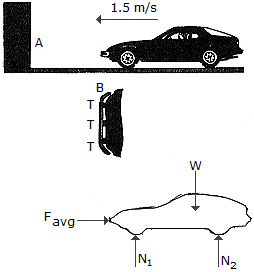Engineering Mechanics - KOP: Work and Energy - Discussion
Discussion Forum : KOP: Work and Energy - General Questions (Q.No. 15)
15.

A car is equipped with a bumper B designed to absorb collisions. The bumper is mounted to the car using pieces of flexible tubing T. Upon collision with a rigid barrier A, a constant horizontal force F is developed which causes a car deceleration of 3g = 29.43 m/s2 (the highest safe deceleration for a passenger without a seatbelt). If the car and passenger have a total mass of 1.5 Mg and the car is initially coasting with a speed of 1.5 m/s, compute the magnitude of F needed to stop the car and the deformation x of the bumper tubing.
Discussion:
Be the first person to comment on this question !
Post your comments here:
Quick links
Quantitative Aptitude
Verbal (English)
Reasoning
Programming
Interview
Placement Papers